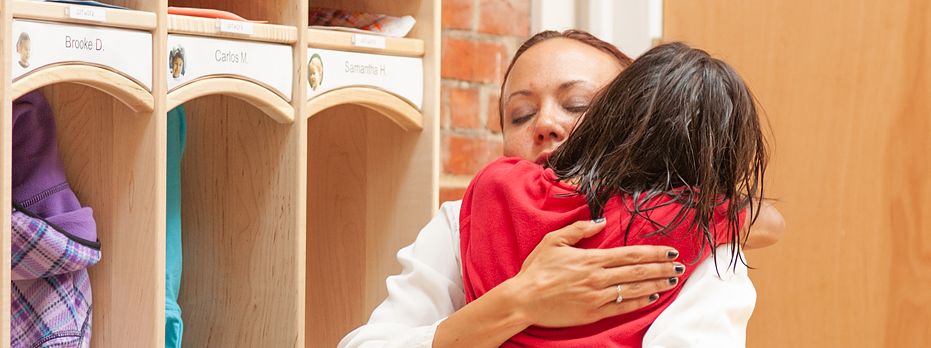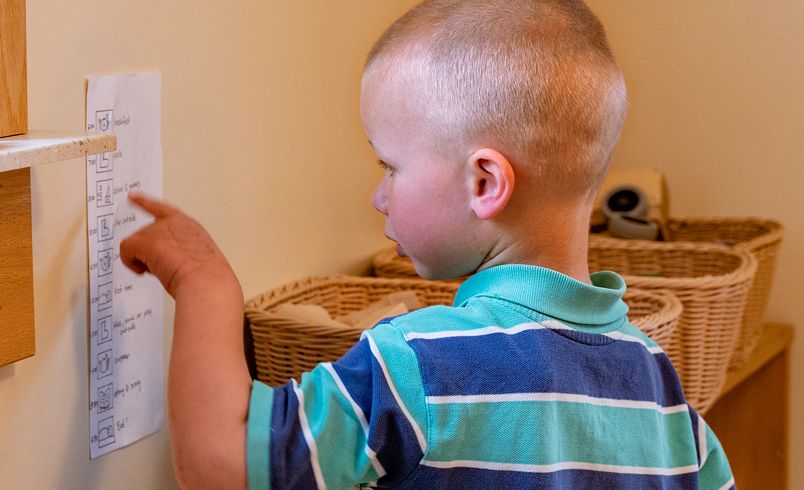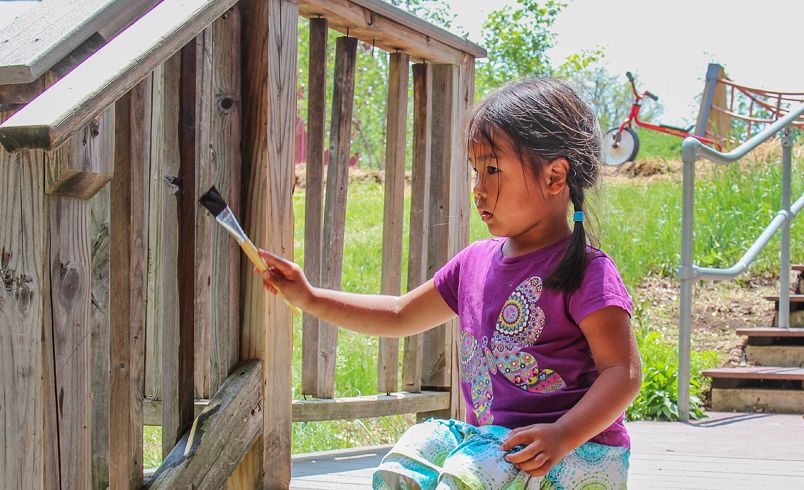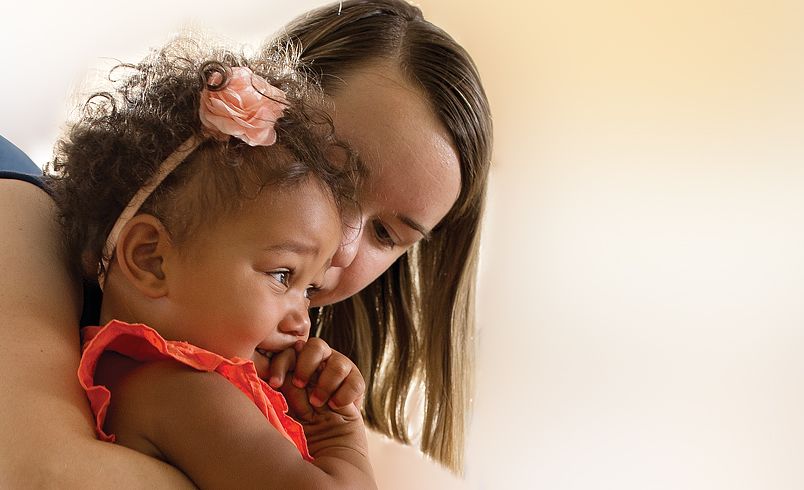Coping with Challenging Behavior during Challenging Times
| May 2020Angela teaches three-year-olds in a program affiliated with a local hospital. Her class normally has ten children in it, but currently several children are staying home with their families. Lately, there have only been four children attending regularly–their parents are health care providers in the hospital and are working long, grueling hours. Under normal circumstances, a smaller class means fewer behavior challenges, but lately it’s been the opposite. The children are quick to lose emotional control, more likely to lash out at each other, and less independent in their play. Children who had been using the toilet without problems for months are suddenly having regular accidents, and naptime is a daily struggle.
Angela also has a two-year-old son, Joshua, spending his days at home with her husband who is teleworking. They are seeing many of the same challenging behaviors in him, along with more frequent night waking and tantrums.
The current COVID-19 crisis has drastically changed daily life for many children and families. Children who once spent much of their days in early childhood programs are home with their parents who may also be coping with teleworking or sudden unemployment. Children who remain in the early childhood setting because their parents’ work is deemed essential, may also have big changes both at school and at home.
Those of us who work with young children know stress often translates into an uptick in challenging behaviors. Tantrums, meltdowns, sleep disruptions, and regression are all ways that children may show that they are having a hard time. So, what can parents and caregivers do to help? Here are three ideas for supporting children’s emotional development and managing challenging behaviors during challenging times, whether you are at home caring for your own children or working in early childhood programs supporting parents in vital roles in your community.
1. Create a predictable, flexible schedule that minimizes transitions.
In Angela’s classroom, children are used to following a schedule. She has pictures posted of them doing everyday activities like playing outside and eating lunch, and she often directs their attention to their visual schedule when they ask about what comes next. Lately, she has been emphasizing it more, talking lots about what is happening now and what they will do afterwards. She also added long blocks of free play and outdoor time, even eating lunch outdoors when the weather permits.
Seeing how much Joshua is also struggling at home during transition times, she makes a similar visual schedule for him. She takes pictures of him getting dressed, eating breakfast, playing with toys, taking naps, and getting ready for bed, and prints them on her home printer. She and her husband hang the pictures up where her son can see them and point them out when it is time to move from one activity to another. Together, they also brainstorm some ideas for playtime that keep him engaged and busy for longer stretches of time. (For example, Joshua loves baths – her husband begins offering a morning “play bath” after breakfast, working on his computer on the floor while Joshua plays in the water as long as he wants to.)
Young children aren’t planners–under normal circumstances, they don’t think much about the future unless they are worried about it. But, when daily routines are drastically changed, children’s worries about what comes next may show up in their behavior.
A predictable schedule with enough flexibility to accommodate your daily life can help! Children love to know what comes next–when you do the same things in the same order as consistently as you can, it helps them to relax. Make sure your schedule includes long stretches for free play, either with you or on their own, minimizing how often you ask them to switch from one task or location to another. Whether at home or at school, keep this routine streamlined, providing extra time for activities that reduce stress for children, like gross motor and sensory play. If children seem engrossed in an activity, see if you can extend it, even if it shifts your schedule a bit.
Tell children what is happening and what will happen next, offering more reminders than you usually might during this unusual time, and when there are changes to the usual order of events, be sure you let children know in advance. For preschoolers and older children at home, a visual schedule can also help them understand what to expect. It doesn’t have to be anything fancy–if you have a printer, you can print black and white images of your own child eating breakfast, brushing their teeth, or doing other daily activities, and then arrange them in sequence in a place they can see them. You can even draw pictures if you don’t have a printer! Then, point out the pictures as you prepare to move from one activity to the next.
2. Adjust your expectations—accommodate regression and meet children where they are.
Art time has long been a favorite activity in Angela’s classroom. Earlier this year, it was an activity most children could participate in independently, allowing her time to spend time with individual children or jot down notes to share with families. Lately, art time has been a disaster. Arguments over supplies are constant, children are easily frustrated with their projects, and spills are frequent and disruptive. After a few challenging days of art time, Angela decides to change up the art center. She puts away the paints and glue, leaving out crayons and a few colors of paper. In their outdoor play space, she adds sidewalk chalk and introduces children to “painting with water,” giving them brushes to make designs on the wooden fence that quickly dry, allowing for new creations to replace them. With more space and less structure, the children are able to enjoy art time again.
At home, Angela notices Joshua is also struggling with some things that used to be easy for him–bedtime in particular. After several nights of long, frustrating bedtime struggles, she decides to pull out some of the books they read at bedtime when he was a younger baby and offers him his special blanket, which had been in a drawer for the last few months. Tonight, instead of kissing him goodnight in his bed, she rocks him for a few minutes after they read a book, letting him get sleepy in her arms before putting him to bed. With the extra support, their bedtime routine begins to get easier–for Joshua and for Angela!
Many families are dealing with enormous changes in their daily lives, juggling the responsibilities of working and schooling from home while trying to manage the stress of sharing spaces in ways they are not used to. Children and adults alike miss their friends and their daily routines. Living with uncertainty and anxiety around the pandemic takes a toll on our emotional energy. We are all doing the best we can in very challenging times.
Children don’t necessarily understand what is happening in the adult world around them, and they may not have the language to express their worries. But, they are exquisitely sensitive to the tenor of adult emotions, and even infants may know that something isn’t quite right.
A very common response to stress in children is regression. Some common areas for regression include sleep, toileting, problem-solving, and independence. Children may be clingy or demanding, or revert to behaviors you haven’t seen in awhile, like climbing in bed with you at night. Even language might regress–you might hear “baby talk”, or find that early literacy or math skills seem to have suddenly disappeared.
Try not to worry about these changes. Instead, meet children where they are. If your three-year-old suddenly wants to be rocked to sleep again, try to accommodate her if you can (or offer a compromise: “I can rock you for five minutes, and then I will tuck you into your bed and kiss you goodnight.”) Forgo structured academic activities–instead, spend more time reading together and talking about things you see and do together, building language, literacy, and math skills in your everyday interactions instead. Offer familiar foods, keep your days simple, and offer lots and lots of opportunity to play. Take the opportunity to nurture your little ones and hold them tight just a little longer. Over time, most children will go back to their more grown-up ways as things start to feel more normal.
3. Attend to your own emotional well-being.
Author and advocate L.R. Knost wrote, “When little people are overwhelmed by big emotions, it’s our job to share our calm, not join their chaos.” This can be exceptionally difficult to do when we don’t have much calm to share! During challenging times, it is critical that adults caring for children also care for ourselves so that challenging behaviors don’t overwhelm us when they arise.
The best way to attend to your own emotional well-being varies widely, depending on your temperament and circumstances–there is no one-size-fits-all solution. For most people, extra attention to good sleep, nutritious food, and healthy movement are a good start. Reaching out with phone calls or video chats to people who can support and nurture us emotionally is also a great strategy for maintaining emotional balance, as is limiting time spent on social media. No matter which strategy you choose, the most important thing is that you take time daily to recharge, even if just for a few minutes.
Here are a few good places to look for ideas for self-care:
Young Children at Home during the COVID-19 Outbreak: The Importance of Self-Care from ZERO TO THREE
Stress and Coping from the Centers for Disease Control and Prevention
Fifty Ways to Take a Break – a free printable infographic you can hang up at home!
Take good care of you–your work with children is so important, and your well-being matters, too!
It’s Friday and it has been a long week for Angela—she is looking forward to time to rest and recharge over the weekend. In the evening, she and her husband cook a special meal and put on a favorite cartoon for Joshua while the adults eat together and reconnect. Afterwards, her husband puts Joshua to bed while she takes a long bath, listening to her favorite music and letting her body relax. She heads to bed early, catching up on much needed sleep so she’s ready to be fully present with her family the next day.
Reference List
Fiechtner, J., Forrester, M., & Albrecht, K. Five parenting strategies to support emotional development. (2018). Tomball, Texas: Innovations in ECE Press.
Forrester, M. & Albrecht, K. Social emotional tools for life: an early childhood teacher’s guide to supporting strong emotional foundations and successful social relationships. (2014). Tomball, Texas: Innovations in ECE Press.










